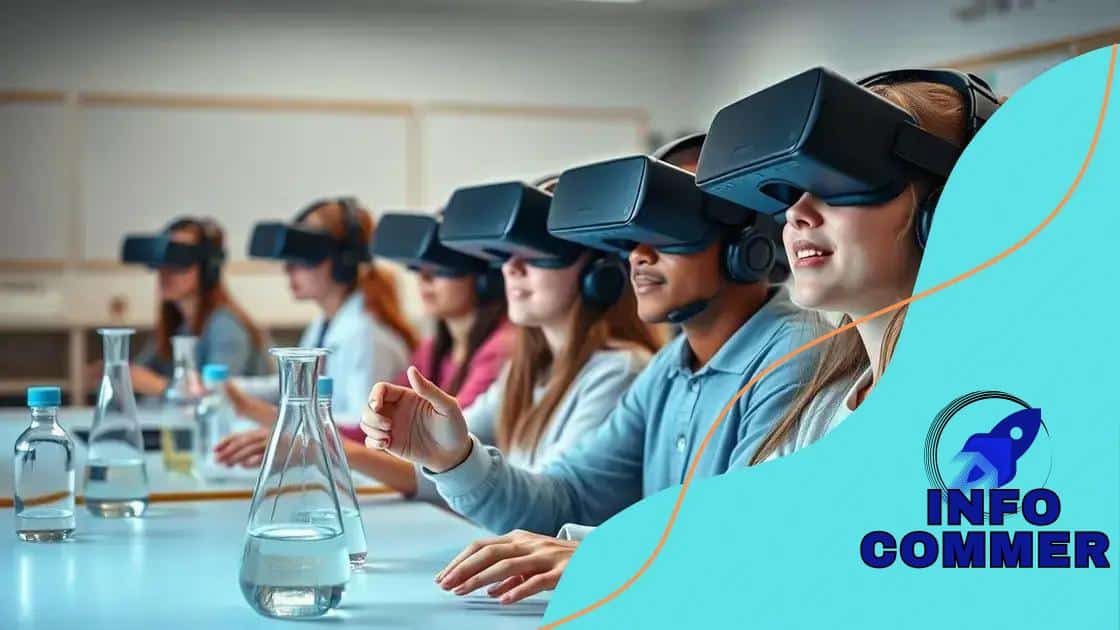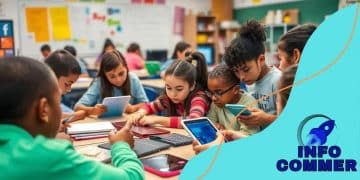Virtual reality’s role in immersive science education

Virtual reality’s role in immersive science education enhances engagement and retention, offering students experiential learning opportunities that make complex concepts more accessible and impactful.
Virtual reality’s role in immersive science education is reshaping how students interact with complex scientific concepts. Imagine stepping into a molecular structure instead of just reading about it; this technology promises a more engaging learning experience.
Understanding the basics of virtual reality
Understanding virtual reality (VR) is crucial for grasping its benefits in education. VR allows students to immerse themselves in different environments, enhancing their learning experiences significantly. This technology promotes active engagement, which is more effective than traditional learning methods.
What is Virtual Reality?
Virtual reality is a simulated experience that can mimic or differ from the real world. It uses technology to create a 3D environment which users can interact with using special equipment like headsets and controllers. This interaction provides a sense of presence, making users feel like they are truly experiencing another world.
Key Components of VR
- Headsets: These devices display the virtual environment and often include motion sensors.
- Controllers: Hand-held devices that help users navigate and interact within the virtual space.
- Software: Programs that create and manage the VR environments and experiences.
- Tracking Systems: These ensure that movements are accurately reflected in the virtual world.
Many students find learning more enjoyable when they can visually and interactively explore concepts. With virtual reality, complex subjects like biology or physics come to life. Imagine students walking through the human body or orbiting planets in our solar system. This kind of immersive learning not only makes education fun but also helps in retaining information better.
How VR Supports Learning
VR has unique advantages that traditional methods lack. One of its most significant benefits is the ability to create realistic simulations. For instance, students can practice surgical procedures in a safe, hands-on manner without the risks associated with real-life operations.
Additionally, VR allows for personalized learning experiences. Students can progress at their own pace, revisiting challenging topics as needed. This tailored approach ensures that everyone, regardless of their learning style, can grasp essential concepts.
How VR enhances science education
How VR enhances science education is a compelling topic, as it reveals exciting ways to make learning more engaging. By immersing students in interactive environments, VR allows them to explore scientific concepts firsthand. This hands-on approach leads to deeper understanding and retention of knowledge.
Interactive Learning Experiences
One of the most powerful features of VR is its ability to create interactive learning experiences. Students can experiment, make discoveries, and visualize processes that are usually abstract. For example, when studying cellular biology, students can observe cells dividing in real-time. This interaction helps solidify complex theories.
Benefits of Virtual Reality in Education
- Increased engagement: VR captivates students’ attention, making lessons memorable.
- Safe practice: Students can conduct experiments without real-world risks, enhancing learning opportunities.
- Visual understanding: Concepts that are hard to visualize become clear through immersive experiences.
- Collaboration: Students can work together in virtual labs, promoting teamwork and communication.
Through VR, students can also explore environments that would be impossible to access in real life. For instance, they can travel back in time to witness scientific events or explore the depths of the ocean. These experiences nurture curiosity and inspire a passion for science.
Critical Thinking and Problem-Solving
Moreover, VR challenges students to think critically and solve problems. When facing real-life scenarios in a virtual space, students must apply their knowledge effectively. This form of learning encourages analytical thinking and creativity. Instead of memorizing facts, students learn to apply concepts, which enhances their overall education.
Incorporating VR into science education also accommodates various learning styles. Visual learners benefit from the rich graphics, while kinesthetic learners engage actively with the material. This flexibility makes VR a valuable tool in diverse classrooms.
Examples of VR in classroom settings

Examples of VR in classroom settings showcase how this technology can transform education. Various schools and educators are successfully integrating VR into their curricula, providing unique learning opportunities. By examining these examples, we can see the vast potential of VR in enhancing student engagement and understanding.
1. Virtual Field Trips
Many classrooms use VR to facilitate virtual field trips. For instance, students can explore the Amazon rainforest or walk on the moon without leaving their classrooms. These immersive experiences allow students to visit places they may never see in real life, making lessons more tangible and exciting.
2. Simulated Laboratory Experiments
Another compelling use of VR in education is simulating laboratory experiments. Instead of only reading about chemical reactions, students can interact with virtual lab equipment. This hands-on approach helps them grasp complex scientific concepts and develop practical skills in a safe environment.
3. Historical Reenactments
- Ancient Civilizations: Students can experience life in ancient Rome or Greece, walking through historic sites.
- Famous Events: VR can transport learners to key moments in history, like the signing of the Declaration of Independence.
- Cultural Immersion: Exploring different cultures through VR can enhance students’ understanding and appreciation of diversity.
These immersive reenactments not only make history more engaging but also help foster critical thinking by allowing students to analyze historical events through the eyes of those who lived them. In a VR setting, they can better understand the motivations and emotions behind historical actions.
4. STEM Learning Simulations
In STEM education, VR can support complex problem-solving. For example, students can virtually build and test bridges or racetracks. They learn engineering principles while engaging in trial and error, which enhances critical thinking and innovation. This type of learning promotes teamwork as students collaborate to achieve shared goals.
Overall, these examples of VR in classrooms illustrate how technology can create captivating learning environments. As VR continues to evolve, its applications in education will likely grow, providing even more innovative ways to learn and explore.
Benefits of immersive learning through VR
The benefits of immersive learning through VR are numerous and significantly impact education. By integrating VR into learning, educators can create dynamic environments that stimulate students’ curiosity and engagement. This approach not only makes learning more enjoyable but also helps students grasp complex concepts more effectively.
1. Enhanced Engagement
One of the primary benefits of VR is enhanced engagement. When students wear VR headsets, they enter an immersive world that captures their attention. This focused environment allows learners to concentrate better on the material. As a result, students are more likely to participate actively in the learning process.
2. Improved Retention of Knowledge
- Active participation: Engaging with content in a virtual setting leads to better memory retention.
- Real-life contexts: Learning in meaningful contexts helps students remember important concepts.
- Experiential learning: Experiencing lessons firsthand allows students to connect ideas with reality.
These factors contribute to improved retention of knowledge. Students who learn through VR often report remembering information longer than those who learn through traditional methods.
3. Personalized Learning Experiences
VR also offers personalized learning experiences that cater to individual students’ needs. Learners can progress at their own pace, revisiting difficult topics until they understand fully. This adaptability is crucial for diverse classrooms, where students have different learning styles and speeds. In this way, immersive learning ensures that all students can achieve their educational goals.
4. Safe Learning Environment
The use of VR creates a safe space for students to experiment and learn. In virtual environments, students can make mistakes without real-world consequences. This freedom encourages risk-taking and fosters a spirit of exploration, which is vital in scientific learning.
Overall, the benefits of immersive learning through VR demonstrate its potential to transform educational experiences, making them more effective and enjoyable. As technology continues to advance, the possibilities for VR in education will only expand, offering even more ways to enhance the learning experience.
Challenges and future of VR in education
The challenges and future of VR in education present a complex landscape as this technology evolves. While VR offers many benefits, there are obstacles that schools and educators face in implementing it effectively. Understanding these challenges is crucial for maximizing its potential in classrooms.
1. Cost of Implementation
One major challenge is the cost of VR technology. Many schools struggle with tight budgets, making it difficult to invest in headsets, software, and necessary infrastructure. Although prices are decreasing, the initial investment can still be a barrier for many educational institutions.
2. Training for Educators
- Need for professional development: Teachers need proper training to integrate VR into their lesson plans effectively.
- Resource availability: Access to materials and ongoing support can be limited.
- Time constraints: Educators may find it challenging to incorporate new technologies into already busy schedules.
Without adequate training, teachers may feel overwhelmed and unsure of how to make the most of VR. This, in turn, can lead to missed opportunities for students to benefit from immersive learning.
3. Technical Challenges
Technical issues can also hinder the adoption of VR in classrooms. These may include hardware malfunctions, software glitches, and connectivity problems. These challenges can disrupt lessons and frustrate both teachers and students. Ensuring smooth operations is vital for a successful learning experience.
4. Content Accessibility
Another concern is the availability of quality content. While some excellent VR educational programs exist, they are often limited in scope. Schools may need to develop their own materials or adapt existing ones, which can take time and resources. Moreover, the content must align with curriculum standards to be effective.
Looking to the future, the landscape of VR in education is promising, with ongoing advancements in technology. As VR becomes more affordable and accessible, its applications in learning are likely to expand. Innovative developers are continually creating more engaging and educational experiences that cater to various subjects.
Furthermore, as educators gain more experience and training with VR, they will discover new ways to integrate it into their classrooms effectively. Collaborative projects, peer-based learning, and cross-disciplinary applications are all possibilities that could enhance student engagement.
FAQ – Frequently Asked Questions about Virtual Reality in Education
What are the main benefits of using VR in the classroom?
The primary benefits include enhanced engagement, improved retention of knowledge, and personalized learning experiences for students.
What challenges do schools face when implementing VR?
Challenges include high costs, the need for proper training for educators, and access to quality content and technology.
How can VR improve students’ understanding of complex subjects?
VR allows students to explore complex subjects through immersive experiences, making abstract concepts more tangible and relatable.
What does the future hold for VR in education?
The future of VR in education looks promising, with ongoing technological advancements and increasing accessibility, leading to more innovative teaching methods.





